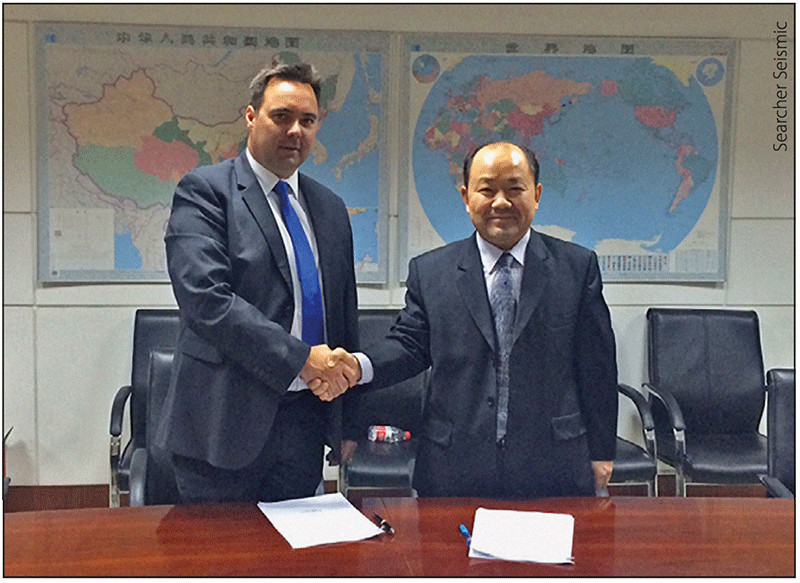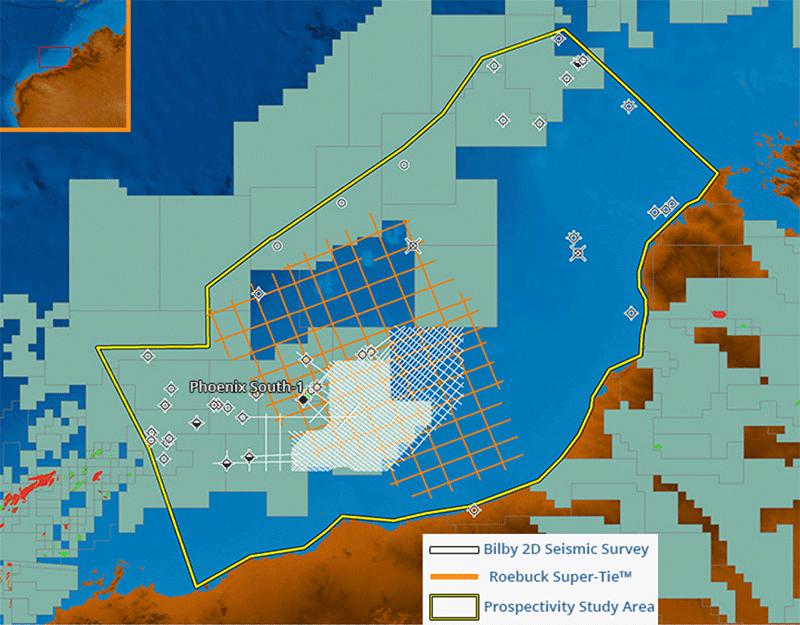In the present rather straightened times, many people in the oil and gas industry believe that collaboration, even across continents, is the way forward for the future.
 Searcher Seismic’s General Manager, Alan Hopping with BGP’s President Marine and MC, Haibo Liu.Two companies which are enthusiastically putting this theory into practice are Searcher Seismic, which is headquartered in Perth, Australia, and Chinese-based BGP, which have consolidated their ongoing association with two recent collaborations.
Searcher Seismic’s General Manager, Alan Hopping with BGP’s President Marine and MC, Haibo Liu.Two companies which are enthusiastically putting this theory into practice are Searcher Seismic, which is headquartered in Perth, Australia, and Chinese-based BGP, which have consolidated their ongoing association with two recent collaborations.
In February, they announced a commercial marketing agreement which provides BGP with an exclusive right to market the Searcher multi-client 2D and 3D seismic library within China and receive commission fees on the sales of this data. The agreement covers more than 900,000 km of 2D and 80,000km2 of 3D seismic data from Searcher’s global database. Searcher believe that this agreement with BGP is very exciting as it helps open the door to Chinese-based oil companies as they look to expand their presence around the globe. The company hopes that in addition to marketing its existing data, the agreement will help develop new projects for the Chinese market.
Canning Basin Survey
Further strengthening the relationship between the two companies, in March they embarked on Bilby, a new 2D non-exclusive survey of the Bedout Sub-basin and Broome Platform, in the Canning Basin offshore north-west Australia. This will be carried out close to Apache’s Phoenix South-1 discovery, which in August last year confirmed a structure originally identified back in 1980, resulting in a wholesale change in thinking regarding the prospectivity of the area. Logging and pressure data from Phoenix South-1 confirmed at least four separate oil columns ranging from 26 to 46m in the Triassic Lower Keraudren Formation, with early estimates suggesting the possibility of 300 MMbo in place.
 The location of the Bilby 2D seismic survey in the Canning Basin.The Bilby 2D seismic is being acquired by the BGP Explorer using high-end Sercel Sentinel Solid Streamer technology, Sercel GII Gun Source equipment and continuous recording. The survey comprises approximately 12,300 km of 2D long-offset, high resolution broadband data over 2×4, 4×8 and 8×8 km grids and has been designed to provide modern, high quality data to help identify prospective structural and stratigraphic trends that can be used for regional evaluations and future detailed seismic survey design. Seismic data processing will be undertaken by Perth-based DownUnder GeoSolutions, with initial deliverables being DUG Broad PSTM data, while final results can be expected from June 2015.
The location of the Bilby 2D seismic survey in the Canning Basin.The Bilby 2D seismic is being acquired by the BGP Explorer using high-end Sercel Sentinel Solid Streamer technology, Sercel GII Gun Source equipment and continuous recording. The survey comprises approximately 12,300 km of 2D long-offset, high resolution broadband data over 2×4, 4×8 and 8×8 km grids and has been designed to provide modern, high quality data to help identify prospective structural and stratigraphic trends that can be used for regional evaluations and future detailed seismic survey design. Seismic data processing will be undertaken by Perth-based DownUnder GeoSolutions, with initial deliverables being DUG Broad PSTM data, while final results can be expected from June 2015.
Tying nicely in with the Bilby survey will be Searcher’s Roebuck Super-Tie™, a regional grid comprising over 5,000 km of reprocessed PSTM data, which will be available in May 2015.
In a further example of collaboration, Searcher Seismic, in conjunction with Insight Petroleum, have recently completed an Offshore Canning Area Prospectivity Study, which aims to provide timely and strategic information to assist companies in understanding the implications of the recent Phoenix South-1 discovery and the prospectivity of the Bedout, Rowley and Oobagooma Sub-basins and adjacent platform areas. Searcher believes that substantial potential appears to exist not only in and around the Phoenix South area, but up-dip on the flanks of the basin, where the results of Keraudren-1, a Roebuck Basin BHP well from 1973, demonstrate that significantly better quality reservoirs exist within the Triassic sediments. There is also the potential for oil to migrate up onto the adjacent Broome Platform into accumulations analogous to the Stag, Gwydion and Cornea fields elsewhere in the region.
Lower oil prices mean that efficiencies of scale, combined marketing and pooling of technological expertise are just three of the advantages to be gained from intercompany collaboration.





